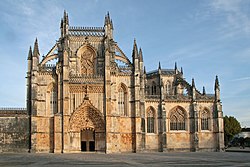Monastery of Batalha
| Batalha Monastery | |
|---|---|
|
Native name Portuguese: Mosteiro da Batalha |
|

Batalha Monastery is one of the most important Gothic sites in Portugal.
|
|
| Location | Batalha, Portugal |
| Coordinates | 39°39′33″N 8°49′34″W / 39.65917°N 8.82611°WCoordinates: 39°39′33″N 8°49′34″W / 39.65917°N 8.82611°W |
| Official name: Batalha Monastery | |
| Type | Cultural |
| Criteria | i, ii |
| Designated | 1983 (7th session) |
| Reference no. | 264 |
| State Party | Portugal |
| Region | Europe and North America |
The Monastery of Batalha (Portuguese: Mosteiro da Batalha), literally the Monastery of the Battle, is a Dominican convent in the civil parish of Batalha, in the district of Leiria, in the Centro Region of Portugal. Originally, and officially known, as the Monastery of Saint Mary of the Victory (Portuguese: Mosteiro de Santa Maria da Vitória), it was erected in commemoration of the 1385 Battle of Aljubarrota, and would serve as the burial church of the 15th-Century Aviz dynasty of Portuguese royalty. It is one of the best and original examples of Late Gothic architecture in Portugal, intermingled with the Manueline style.
The monastery was built to thank the Virgin Mary for the Portuguese victory over the Castilians in the battle of Aljubarrota in 1385, fulfilling a promise of King John I of Portugal. The battle put an end to the 1383–85 Crisis.
It took over a century to build, starting in 1386 and ending circa 1517, spanning the reign of seven kings. It took the efforts of fifteen architects (Mestre das Obras da Batalha), but for seven of them the title was no more than an honorary title bestowed on them. The construction required an enormous effort, using extraordinary resources of men and material. New techniques and artistic styles, hitherto unknown in Portugal, were deployed.
...
Wikipedia
